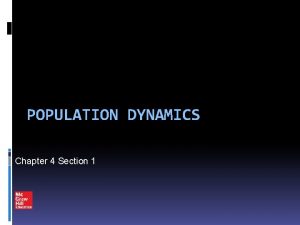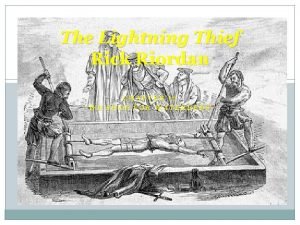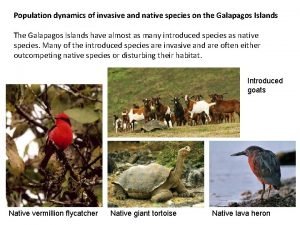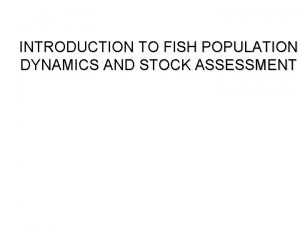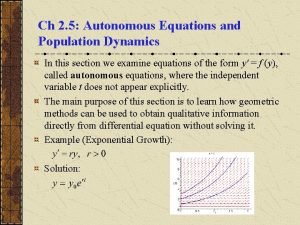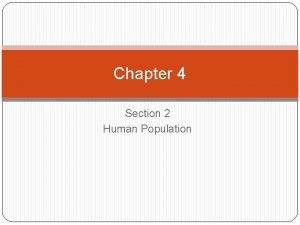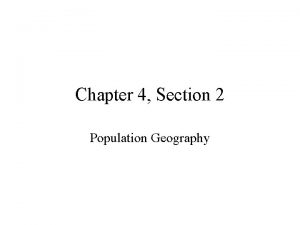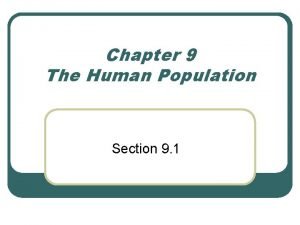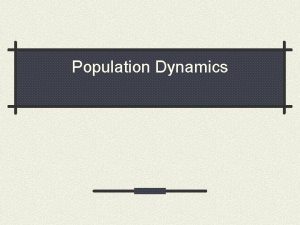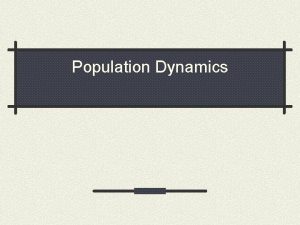POPULATION DYNAMICS Chapter 4 Section 1 Main Idea

















- Slides: 17

POPULATION DYNAMICS Chapter 4 Section 1

Main Idea Populations of species are described density, spatial distribution, and growth rate.

Thinking Questions What are the characteristics of populations and how they are distributed? What are the differences between densityindependent and density-dependent limiting factors? What are the similarities between the different models used to quantify the growth of a population? How does carrying capacity affect reproductive rates?

Population Characteristics • Populations are groups of the same species in the same area. • Characteristics of populations that are used to classify them include density, distribution, and growth rate

Population Characteristics Population density • The number of organisms per unit area is the population density.

Population Characteristics Spatial distribution • Dispersion is the spacing pattern of a population. • Can be uniform, clumped groups, or random • Uniform- bears, bald eagles, corn • Clumped- bison, lions • Random- deer, dandelions • Pattern primarily driven by resources such as food

Population Characteristics Population ranges • No population occupies all habitats in the biosphere • A species’ range is its distribution across the environment. • Hawaiian Honeycreeper has limited population range while the Peregrine Falcon has vast population range • A species might not be able to expand its population range because it cannot survive the abiotic conditions found in the expanded region.

Population. Limiting Factors • Limiting factors are biotic or abiotic forces that keep populations from increasing indefinitely. • Limiting factors are either density-independent or density-dependent.

Population. Limiting Factors Density-independent factors • Any factor in the environment that does not depend on the number of members in a population per unit area is a density-independent factor. • Usually abiotic, and include: • Weather events • Fire • Human alterations of the landscape-land development, dams, fishing practices • Air, land, and water pollution

Population. Limiting Factors Density-dependent factors • Any factor in the environment that depends on the number of members in a population per unit area is a density-dependent factor. • Often biotic, and include: • Predation • Disease ~When population density is high, diseases can spread more quickly • Competition ~Increases as density increases • Parasites

Population. Limiting Factors Population growth rate • The population growth rate (PGR) explains how fast a given population grows. • Natality: birthrate of a population in a given year (number of individuals born) • Mortality: the number of individuals who die in a given year • Emigration: number of individuals moving away from a population • Immigration: number of individuals moving into a population

Population. Limiting Factors Population growth rate • Exponential growth model: J-shaped growth curve • Occurs when growth rate is proportional to population size • Begins with a lag phase, or slow growth rate phase • All populations grow exponentially until they encounter a limiting factor.

Population. Limiting Factors Population growth rate • Logistic growth model: S-shaped growth curve • Occurs when a population’s growth slows or stops following exponential growth, at the population’s carrying capacity • A population stops increasing when the number of births < number of deaths, or when emigration > immigration.

Population. Limiting Factors Population growth rate • Carrying capacity is the maximum number of individuals in a species that an environment can support.

Population. Limiting Factors Reproductive patterns • Species vary in the number of births per reproduction cycle, age that reproduction begins, and in the life span. • Plants and animals are placed into groups based on their reproductive factors. • r-strategists or k-strategist

Population. Limiting Factors Reproductive patterns r-strategy k-strategy Rate strategy Carrying-capacity strategy Adapted for fluctuating environment Adapted to stable environment Generally small Generally large Short life span Long life span Many offspring Few offspring Expend little energy to raise Invest more energy into young nurturing young

Thinking Questions What are the characteristics of populations and how they are distributed? What are the differences between densityindependent and density-dependent limiting factors? What are the similarities between the different models used to quantify the growth of a population? How does carrying capacity affect reproductive rates?
 Chapter 4 section 1 population dynamics
Chapter 4 section 1 population dynamics Chapter 4 population ecology section 1 population dynamics
Chapter 4 population ecology section 1 population dynamics Population ecology section 1 population dynamics answer key
Population ecology section 1 population dynamics answer key Population ecology section 1 population dynamics
Population ecology section 1 population dynamics Main ideas examples
Main ideas examples Chapter 4 section 1 population dynamics
Chapter 4 section 1 population dynamics Chapter 4 section 1 population dynamics
Chapter 4 section 1 population dynamics Is theme and central idea the same thing
Is theme and central idea the same thing Supporting idea
Supporting idea Is the main idea the theme
Is the main idea the theme Which of the supporting details or sentences is irrelevant?
Which of the supporting details or sentences is irrelevant? What happens in chapter 17 of the lightning thief
What happens in chapter 17 of the lightning thief Population dynamics
Population dynamics Fish population dynamics and stock assessment
Fish population dynamics and stock assessment Autonomous equations and population dynamics
Autonomous equations and population dynamics Chapter 4 section 2 human population answer key
Chapter 4 section 2 human population answer key Chapter 4 section 2 population geography
Chapter 4 section 2 population geography Chapter 9 the human population section 1
Chapter 9 the human population section 1





